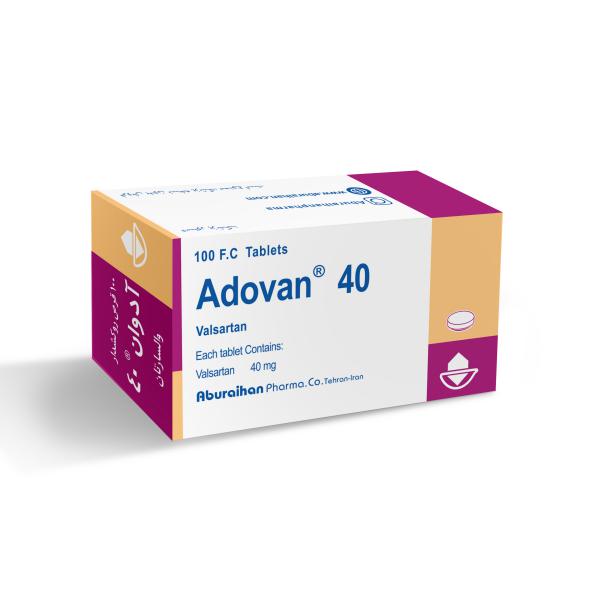Adovan®
Valsartan
40, 80, 160 mg film coated tablet
Heart failure with reduced ejection fraction: Treatment of heart failure (NYHA class II to IV) in adults.
Hypertension, chronic: Management of hypertension in adults and pediatric patients ≥1 year of age.
Post–myocardial infarction: Reduction of cardiovascular mortality in patients with left ventricular dysfunction or failure following myocardial infarction (MI) (eg, acute coronary syndromes such as ST-elevation MI or non–ST-elevation MI) in adults.
Mechanism of Action:
Valsartan produces direct antagonism of the angiotensin II (AT2) receptors, unlike the ACE inhibitors. It displaces angiotensin II from the AT1 receptor and produces its blood pressure-lowering effects by antagonizing AT1-induced vasoconstriction, aldosterone release, catecholamine release, arginine vasopressin release, water intake, and hypertrophic responses. This action results in more efficient blockade of the cardiovascular effects of angiotensin II and fewer side effects than the ACE inhibitors.
Method of Administration:
Non–ST-elevation acute coronary syndrome:
Oral: Initial: 20 mg twice daily; may increase dose as tolerated up to 160 mg twice daily under close monitoring to avoid hypotension.
Heart failure with reduced ejection fraction:
Oral: Initial: 20 to 40 mg twice daily; increase dose, typically by doubling, every 1 to 2 weeks based on response and tolerability to a target dose of 160 mg twice daily. In closely monitored hospitalized patients, the dose may be titrated at 1- to 2-day intervals.
Hypertension, chronic:
Oral: Initial: 80 to 160 mg once daily; evaluate response after ~2 to 4 weeks and titrate dose (eg, increase the daily dose by doubling) as needed up to a maximum of 320 mg once daily; if additional blood pressure control is needed, consider combination therapy. Patients with severe asymptomatic hypertension and no signs of acute end organ damage should be evaluated for medication titration within 1 week.
Notes
Contraindications:
Hypersensitivity to valsartan or any component of the formulation; concomitant use with aliskiren in patients with diabetes mellitus.
Documentation of allergenic cross-reactivity for angiotensin II receptor blockers is limited. However, because of similarities in chemical structure and/or pharmacologic actions, the possibility of cross-sensitivity cannot be ruled out with certainty.
Interactions:
Angiotensin-Converting Enzyme Inhibitors: Angiotensin II Receptor Blockers may enhance the adverse/toxic effect of Angiotensin-Converting Enzyme Inhibitors. Angiotensin II Receptor Blockers may increase the serum concentration of Angiotensin-Converting Enzyme Inhibitors. Management: Use of telmisartan and ramipril is not recommended. It is not clear if any other combination of an ACE inhibitor and an ARB would be any safer. Consider alternatives when possible. Monitor blood pressure, renal function, and potassium if combined. Risk D: Consider therapy modification
Antihepaciviral Combination Products: May increase the serum concentration of Valsartan. Management: Consider decreasing the valsartan dose and monitoring for evidence of hypotension and worsening renal function if these agents are used in combination. Risk D: Consider therapy modification
Pregnancy and Lactation:
Drugs that act on the renin-angiotensin system can cause injury and death to the developing fetus. Discontinue as soon as possible once pregnancy is detected.
It is not known if valsartan is present in breast milk.
Due to the potential for serious adverse reactions in the breastfed infant, breastfeeding is not recommended
Warning and Precaution:
- Angioedema: Angiotensin II receptor antagonists (ARBs) do not appear to elevate the risk of angioedema. Patients with a history of angioedema due to an angiotensin-converting enzyme inhibitor must be educated that sometimes there can be recurrence within months following discontinuation. No matter the cause of angioedema, prolonged frequent monitoring is required, especially if tongue, glottis, or larynx are involved, as they are associated with airway obstruction. Discontinue therapy immediately if angioedema occurs. Aggressive early management is critical. IM administration of epinephrine may be necessary. Do not readminister the ARB to patients who experience angioedema from this medication.
- Hyperkalemia: May occur; risk factors include renal dysfunction, diabetes mellitus, concomitant use of potassium-sparing diuretics, potassium supplements, and/or potassium-containing salts. Use with caution with these agents; monitor potassium closely.
- Hypotension: Symptomatic hypotension may occur upon initiation in patients who are salt- or volume-depleted (eg, those treated with high-dose diuretics); correct volume depletion prior to administration. This transient hypotensive response is not a contraindication to further treatment with valsartan.
- Renal function deterioration: May be associated with deterioration of renal function and/or increases in serum creatinine, particularly in patients with low renal blood flow (eg, renal artery stenosis, heart failure) whose GFR is dependent on efferent arteriolar vasoconstriction by angiotensin II; deterioration may result in oliguria, acute renal failure, and progressive azotemia. Small increases in serum creatinine may occur following initiation; consider discontinuation only in patients with progressive and/or significant deterioration in renal function.
Adverse Reactions:
Dizziness, Increased blood urea nitrogen, Hypotension, Hyperkalemia, Abdominal pain, diarrhea, nausea, Neutropenia
Storage:
Store below 30 and protect from light and moisture.



